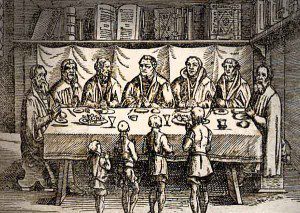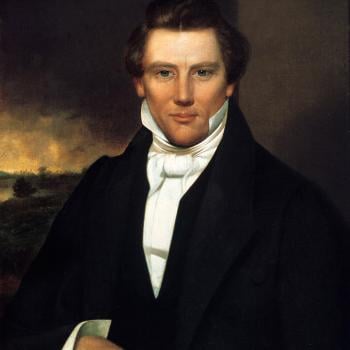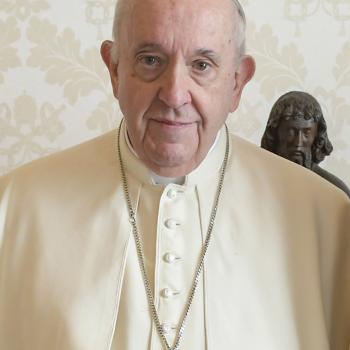In his published account of his first visionary experience, Joseph Smith reported that a Methodist preacher reacted to his report of his vision with utter contempt: “he treated my communication not only lightly, but with great contempt, saying it was all of the devil, that there were no such things as visions or revelations in these days; that all such things had ceased with the apostles, and that there would never be any more of them.”
One of the more remarkable and compelling aspects of early Mormonism was the insistence of the Church of Christ (as the church was called in its infancy) that the spiritual gifts of the New Testament (and of followers of Jesus Christ throughout the ages) had not ceased. Believers prophesied. They healed the sick. They spoke (and sang) in tongues. They offered interpretation when others spoke in tongues. They saw visions of Jesus Christ, God the Father, and angels. The heavens parted with regularity, especially during the church’s first fifteen years or so. This in contrast to the Protestantism of Joseph Smith’s day, in which most ministers believed that visions and revelations and “all such things had ceased with the apostles.”
In histories of Mormonism, I often encounter the idea that most Protestants of the early nineteenth century believed in the cessation of revelation and in the cessation of spiritual gifts and miracles. That has always struck me as incorrect. One could, for instance, read an account of Charles Finney’s conversion. While praying in the woods, Finney heard God’s word, God’s voice, speaking biblical promises to him. When he emerged from the woods, he realized that he had been converted.
That evening, Finney went into the back room of his office to pray. “There was no fire, and no light, in the room,” he remembered, “…[n]evertheless it appeared to me as if it were perfectly light.” When Finney shut the door to the room, “it seemed as if I met the Lord Jesus Christ face to face.” Jesus did not speak. The way he looked at Finney, though, prompted the lawyer to collapse at his feet, weep aloud like a child, and make confessions until the tears he shed bathed his savior’s feet. When the encounter ended, Finney returned to his front office, where he felt the Holy Spirit descend upon him “like a wave of electricity.” A Methodist minister treated the young Joseph Smith with contempt, but the country’s most famous Protestant revivalist also claimed — with a bit more equivocation, perhaps — that he had met Jesus Christ “face to face.”
Certainly, there were Protestant ministers who believed that the age of miracles had ceased, but many if not most Protestant believers still lived in that age. Douglas Winiarski, in “Souls Filled with Ravishing Transport,” details the remarkable visionary experiences of radical evangelicals during the early 1740s awakenings in New England. Jonathan Edwards, who had presided over an awakening in Northampton and defended the revivals despite their excesses, cautioned that while visions could be the result of “overpowered” minds and were prone to misinterpretation, they could also be the fruit of God’s Holy Spirit. Wesley, even more so than Edwards, was quite open to the authenticity of visions and dreams. Nearly a century later, American evangelicalism remained thoroughly saturated with experiences of the supernatural.
So where did the idea come from that many Protestants believed that spiritual visions and dreams had ceased? Certainly, some Protestant reformers were wary of visions (as had been a good number of medieval Catholic clergy). In one instance, Martin Luther apparently saw and rejected a vision of Jesus:
On Good Friday last, I being in my chamber in fervent prayer, contemplating with myself, how Christ my Saviour on the cross suffered and died for our sins, there suddenly appeared upon the wall a bright vision of our Saviour Christ, with the five wounds, steadfastly looking upon me, as if it has been Christ himself corporally. At first sight, I thought it had been some celestial revelation, but I reflected that it must needs be an illusion and juggling of the devil, for Christ appeared to us in his Word, and in a meaner and more humble form; therefore I spake to the vision thus: Avoid thee, confounded devil: I know no other Christ than he who was crucified, and who in his Word is pictured and presented unto me. Whereupon the image vanished, clearly showing of whom it came.

The quotation is from Luther’s Table Talk, in my view not the most reliable source. Perhaps a step above the legend of Luther throwing his inkwell at the devil and splashing the wall of the Wartburg, but a bit suspect nonetheless (relying on the later reconstructions of Luther’s dinner guests). Still, it symbolizes at least some Protestant attitudes toward visions. In this vein, visions are at best unnecessary and at worst tools of Satan.
Luther and Calvin did not entirely rule out contemporary visions and dreams as forms of divine communication. According to Phillip Wiebe’s Visions of Jesus, Luther did not want such gifts for himself but allowed that God might grant them to some individuals. Calvin, like Luther, considered visions more likely to be Satanic apparitions than true manifestations from God. In particular, Calvin argued that “the Lord Himself does not appear by visions.” Again according to Wiebe, he was more open to angelic visitations.
Luther and Calvin, thus, were skeptical but not quite doctrinaire on the matter of visions and dreams. My hunch is that Protestant cessationism in terms of visions developed through several related developments. First, more radical Protestant reformers — such as the Anabaptist leaders in Münster, placed more stock in dreams and visions. Less radical reformers thus became more wary of such claims to revelation and manifestations. At the same time, reformers associated dreams and visions with Catholic spirituality. Especially when early Enlightenment figures began making rationalist criticisms of both biblical and contemporary miracles in the seventeenth century, many Protestant ministers responded by even more vigorously dismissing their parishioners’ reports of dreams and visions (which often at least implicitly threatened ecclesiastical authority). At the same time, for all the Protestant distinctions between biblical times and their own, large numbers of respected mainstream Protestant leaders themselves reported such forms of supernatural communication on occasion. Thus, for most American Protestants by the early nineteenth century, the age of visions, indeed of miracles more broadly, had not ceased.












